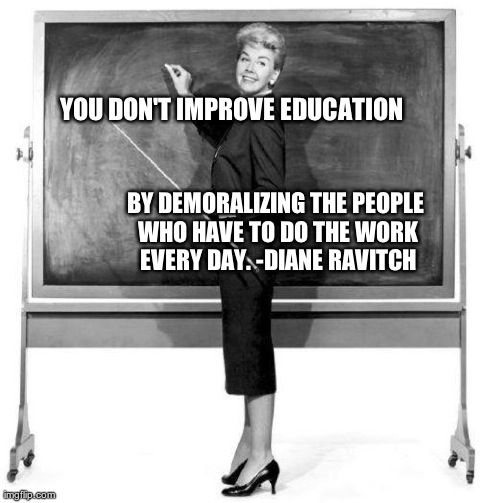Teacher in a Strange Land: Eight Ways We Are Underestimating the Impact of the Pandemic on Public Education
Over the summer, I started tossing links about the impact of the COVID pandemic on public education into a file folder on my desktop, entitled Rebounding from the Pandemic. As of this morning, the file is five pages long, with over 50 links. My working theory is that a global health emergency has had a major impact on kids, their ability to see value in K-12 schooling, their trust in the society where they live to keep them safe, and their hopes and dreams for the future.
About a month ago, I wrote a piece with the same name—Rebounding from the Pandemic–listing some of the things we might have learned and acted on in K-12 education, from experiencing a pandemic:
- The gross inequities in access to wireless capacity and devices.
- The social necessity of being with other children and teenagers in maintaining mental health.
- How faulty-to-useless testing data is in structuring relevant instruction that meets children where they are (which is supposed to be the point of standardized assessments).
- How utterly dependent society in general is on school functioning as M-F childcare.
- How much political leadership and privilege shape our approach to rebounding from a crisis.
All of these obvious issues strike me as an excellent theoretical framework for reconceptualizing public schools and school funding–creating healthy environments for children impacted by various academic and emotional stressors. Our goals right now should not be raising test scores to where they were in 2019 or bringing in thousands of trained counselors (who don’t exist) to deal with mental health problems. The goal is definitely not “getting back to normal.” “Normal” was (and remains) inadequate, inequitable and unprepared for change.
We now should know how frustrating it is, for example, for parents who must work not to have affordable day care available for their elementary schoolchildren. Calculating how much risk to take during a pandemic will vary from person to person—but misdirected anger toward teachers and their unions for not “opening” schools and risking adults’ health, has made entire school districts hotbeds of anger and toxic thinking.
This is what happens when people don’t get the services they feel entitled to, as American citizens. Change is hard.
In fact, the pandemic has changed the entire landscape of public services and social supports—and each of those factors has had an impact on K-12 schools, directly or indirectly. If you think schools have “returned to normal,” ask a teacher whether their current students are achieving at pre-pandemic levels. More importantly, ask whether students have developed the curiosity, communication skills and stamina to work together every day in class. Ask several teachers– have things changed? how?
Here are eight pandemic-driven outcomes impacting the functioning of public schools, as the health crisis fades.
1. Vaccination rates, already worrisomely dropping, now have hit their lowest point since 2011, in spite of laws requiring vaccinations for schoolchildren. You have to ask yourself why parents are not eagerly seeking a vaccination that undoubtedly saved countless lives and reduced hospitalizations: Health officials attributed a variety of factors to this drop in vaccinations, including families being less likely to interact with their family doctor during the pandemic and a “spill-over” effect from misinformation around the COVID-19 vaccine.
2. Book banning, an issue that schools have perennially wrestled with, especially in conservative communities, has now spread to public libraries. ALA President Emily Drabinski explained that while “attacks on libraries right now are shaped and framed as attacks on books” these efforts are really “attacks on people and attacks on children.” In retaliation for advocating against book bans, some conservative states — including Montana, Missouri and Texas — have announced they are “severing ties with the ALA.”
3. The four-day workweek and remote work elbowed their way into traditional M-F/face to face classrooms at the same time they were conceived as the solution to keeping a workplace open during a pandemic. For schools in rural areas where transportation eats up budgets, fewer schooldays and more Zoom classes can keep public schools alive: Hybrid work arrangements have killed the return-to-office hype. Employees equate a mix of working in the office and working from home to an 8 percent raise. They don’t have to deal with the daily hassle and costs of a commute. Remote work saves companies money. It cuts overhead, boosts productivity and is profitable. And what is profitable in a capitalist economy sticks. Remote work also has major benefits for society, including improving the climate by cutting billions of miles of weekly commuting and supporting families by liberating parents’ time.
4. Higher education also seems to be undergoing a metamorphosis, as high school graduates and returning-to-school adults have reassessed the value of a college degree: In a study conducted by the U.S. Census Bureau, the majority of adults who had household members enrolled in college for the fall 2021 term said that their school plans changed.
32% said their classes would occur in different formats.
16% canceled all plans to attend.
12% took fewer classes.
It goes without saying that what impacts our colleges and universities will trickle down to K-12 public schools.
5. Shifts in the need for labor and workforce development have impacted the need for teachers, and what teachers are willing to work for, especially in long-term careers in education. Perhaps Sean Fain, leader of the UAW best expressed this: “Our fight is not just for ourselves but for every worker who is being undervalued, for every retiree who’s given their all and feels forgotten, and for every future worker who deserves a fair chance at a prosperous life. We are all fed up of living in a world that values profits over people. We’re all fed up with seeing the rich get richer while the rest of us continue to just scrape by. We’re all fed up with corporate greed. And together, we’re going to fight to change it.”
6. The incessant media drumbeat of “learning loss” has persuaded people that test scores are more reliable than our own observations about what students are learning, how they’re progressing. From a brilliant article in Rethinking Schools: Shifting blame away from the for-profit healthcare system and the government’s response to the coronavirus is part of what makes the learning loss narrative so valuable to politicians who have no interest in challenging existing patterns of wealth and power. It is a narrative meant to distract the public and discipline teachers. Here’s the recipe: 1. Establish that closing schools hurt students using a narrow measure like test scores; 2. Blame closure of schools on teacher unions rather than a deadly pandemic; 3. Demand schools and teachers help students “regain academic ground lost during the pandemic” — and fast; 4. Use post-return-to-normal test scores to argue that teachers and schools are “failing”; 5. Implement “teacher-proof” (top-down, standardized, even scripted) curriculum or, more insidiously, argue for policies that will mean an end to public schools altogether.
7. School leaders and the education community, used to hard-trimming back budgets year after year, have now witnessed unprecedented levels of greed and corruption in corporate and political circles, taking tax dollars away from struggling schools. From Heather Cox Richardson’s August 24th newsletter: The Department of Justice is bringing federal criminal charges against 371 defendants for offenses related to more than $836 million in alleged COVID-19 fraud, most of it related to the two largest Small Business Administration pandemic programs: the Paycheck Protection Program and Economic Injury Disaster Loans. It’s hard not to wonder how many library books, STEM kits and teachers that $836 million could have bought, as we all rebound from disaster.
8. A mishandled pandemic will likely be followed by political unrest—or, at least, uncertainty. In Ottawa County, Michigan, always a solidly red, conservative county, the 2022 election overturned a more moderate governing board and put in place a collection of people who were angry—furious, in fact– about what happened during the pandemic. Here’s a well-written, balanced story on the impact this political shift is having on people in Ottawa County—a young woman who delivers food to families who need it, a local health department administrator, and other essential programs:
The new budget rejected about $2.2 million in federal covid grants that helped pay for immunizations and could be used tohelp track the spread of hundreds of communicable diseases. It also cut about $400,000 from the department’s health education division, which housed programs that aimed to curb youth suicide, substance abuse and the spread of sexually transmitted disease. The Ottawa Food program was part of that division. County health officials pressed the board to explain the rationale behind the cuts. The answer came in a news release which described how the pandemic had awakened the county’s residents to the “tyranny of public health.” The health department’s misdeeds extended beyond its covid response. Liberal forces throughout government, academia and the nonprofit world were using the department to foist their agendas on his conservative county. “Climate change, gender affirming care, abortion, racial equity and social justice are increasingly identified as public health concerns.”
Pausing here to reflect on the “tyranny of public health,” a phrase that I find chilling, as a veteran teacher.
In the 1970s, Alvin Toffler introduced us to the idea of future shock—too much change in too short a period of time. He made a convincing case that the human psyche was being overloaded, that we weren’t designed to handle so much renovation to our values and habits. And that was before the internet, cell phones and social media transformed the way we communicate and do business, and changed what we expect public education to do for our children.
Something’s happening here, and—as usual—schools are a staging area for political and social change. Some of these changes may ultimately have benefits, strengthening public education. But others are glaring red flags, further chipping away at the commons.

This blog post has been shared by permission from the author.
Readers wishing to comment on the content are encouraged to do so via the link to the original post.
Find the original post here:
The views expressed by the blogger are not necessarily those of NEPC.
